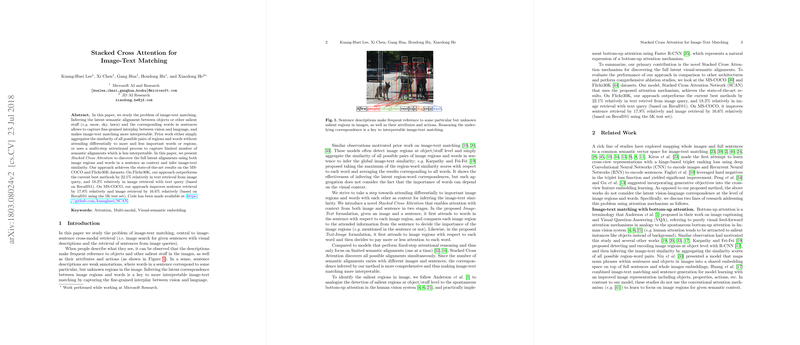Stacked Cross Attention for Image-Text Matching
In the paper "Stacked Cross Attention for Image-Text Matching," the authors introduce a novel approach to enhance the performance and interpretability of image-text matching, a central task in cross-modal retrieval systems. Their solution, termed Stacked Cross Attention Network (SCAN), outperforms existing methods on benchmark datasets like MS-COCO and Flickr30K.
Problem Definition and Motivation
The task of image-text matching involves identifying the correspondence between regions in an image and words in a text description. Traditional methods either aggregate similarities across all pairs or rely on multi-step attentional mechanisms that may focus on limited semantic alignments, thereby reducing interpretability. This paper aims to address these limitations by proposing a model that can capture full latent alignments between image regions and text components.
Methodology
Stacked Cross Attention Mechanism
The core of the paper's methodology is the Stacked Cross Attention mechanism, which is applied in two formulations: Image-Text (i-t) and Text-Image (t-i). Each formulation undergoes a two-stage attention process to infer image-text similarity:
- Image-Text Formulation:
- Stage 1: Words in the sentence are attended with respect to each image region.
- Stage 2: Each image region's importance is determined by comparing it to the attended sentence vector.
- The final similarity between the image and the sentence is computed using LogSumExp (LSE) or average (AVG) pooling.
- Text-Image Formulation:
- Stage 1: Image regions are attended with respect to each word.
- Stage 2: Each word's importance is determined by comparing it to the attended image vector.
- Similarity is also computed using LSE or AVG pooling.
This dual attention mechanism allows for a finer-grained matching process, where the model can simultaneously attend to multiple alignments, making the matching process more comprehensive and interpretable.
Image and Text Representation
For image representation, the paper employs a Faster R-CNN model pretrained on the Visual Genome dataset to detect and encode salient regions. Each region's features are mean-pooled and then transformed into a high-dimensional vector space.
For text representation, words are embedded into vectors and contextually encoded using a bi-directional GRU, producing combined features that capture the semantic context around each word.
Results
The experimental evaluation demonstrates the superiority of the SCAN model over existing methods. On the Flickr30K dataset, SCAN achieves a remarkable 22.1% relative improvement in text retrieval from image queries and an 18.2% improvement in image retrieval with text queries. Similarly, on the MS-COCO dataset, SCAN achieves a 17.8% improvement in sentence retrieval and a 16.6% improvement in image retrieval.
Ablation Studies and Analysis
The paper also includes comprehensive ablation studies that validate the contribution of each component in the proposed model. The studies highlight the critical role of the Stacked Cross Attention mechanism. By comparing to baseline methods and previous models, the paper illustrates that incorporating latent region-word alignments significantly boosts performance.
Furthermore, qualitative analyses showcase the interpretability of the model. Attention visualizations reveal how the model attends to relevant regions and words, offering insights into why specific image-text pairs are matched.
Practical and Theoretical Implications
Practically, the improved performance of SCAN can enhance applications in image captioning, visual question answering, and cross-modal retrieval systems. Theoretically, the paper advances understanding of cross-modal interactions by demonstrating the efficacy of stacked cross attention mechanisms. This can inspire future research to explore similar mechanisms for other multi-modal tasks, potentially broadening the applications in AI and cognitive computing.
Future Directions
Future research may extend this model to more complex datasets or incorporate additional modalities like audio. Another direction could involve exploring more advanced attention mechanisms or integrating SCAN with transformers to leverage their capabilities for handling long sequences.
In conclusion, this paper presents a robust and interpretable solution for image-text matching that sets a new state-of-the-art benchmark, offering a pivotal contribution to the field of multi-modal AI systems.
